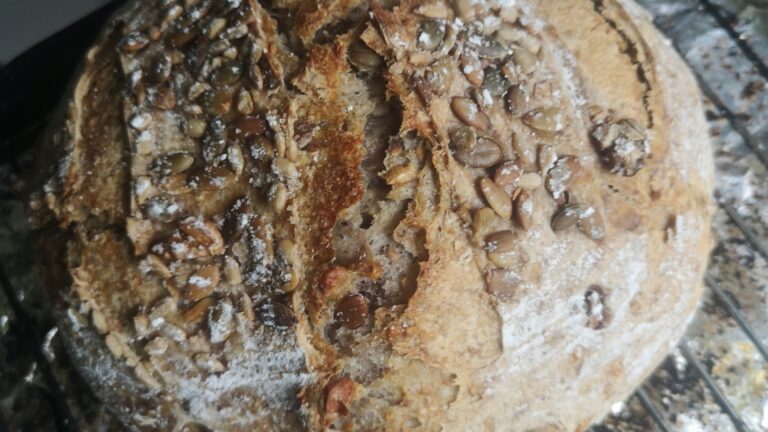Hello, I hope you have had a lovely week…
If you have been following me for a while on social media you might know that I love making sourdough…
It’s become mighty trendy over the last few years (although not as trendy as the banana loaf was over lockdown!).
So what is the deal with sourdough?
1. It tastes AMAZING! Once you have had it, supermarket loaves will never be the same again.
2. The fermenting process makes it easier to digest and more nutrients available.
3. The fermenting process also gives it probiotic properties which can help improve your gut microbes
4. Homemade is always better and there are no additives/preservatives/added sugars
5. Typically it has a lower glycemic index meaning it doesn’t spike your blood sugars like other breads which will help you avoid the afternoon carb crash…
6. You can add all sorts of nuts, seeds, dried fruits to change the flavour and fiber profile.

Sourdough Before you can start making a sourdough loaf, you need a starter. You can get this from someone (like me) that already makes sourdough.
Or you can make your own.
Sourdough Starter In a jar add 25g flour and 25g of water (grams of water, not ml) I use stoneground rye flour as I found this to thrive in my environment.
Leave overnight somewhere warm, covered with a muslin cloth or tea towel, then add another 25g of flour and 25g of water
Leave overnight, always covered, dispose of 50g of the starter and add another 25g of flour and 25g of water
Leave overnight and repeat dispose of 50g of the starter and add another 25g of flour and 25g of water dispose of 50g of the starter and add another 25g of flour and 25g of water
Repeat this process for around 7 days.
Over the days you should start to see your mix coming alive and getting bubbly.
We dispose of some of the mix so we don’t end up with loads and to help the mix come alive.
Anytime you are making a loaf, you will ‘feed’ your starter (equal measures of flour and water).
Either leave the starter overnight to use in the morning or sit somewhere warm to get the bacteria working.
Then take out 150g of the starter mix – always make sure you leave some starter for the next time so you don’t need to keep making a fresh starter.
I usually feed my starter with 75g flour, 75g water (because I am taking out 150g for my loaf).
Making a loaf – it’s timely, but 100% worth it
Once you have a live starter, then you can make your loaf. I make mine:
500g organic flour
300g water (weighed liquid)
150g starter
10g salt
a cup of mixed seeds/nuts
Mix everything through, and leave to stand for around an hour in a bowl covered with plastic wrap (cling film) using a plastic spatula stretch & fold the mix about 35 times, leave to sit for 10mins then repeat another 3 times until your dough starts to become a firm ball (and doesn’t break up when you stretch and fold) Sometimes you need to do this more, other times less. The more you bake the bread, the more you will get a sense of what feels right. It never works out the exact same.
Once you are happy with your ball of dough, dust a proving basket or another bowl with corn or rice flour (starchy but no gluten so the dough doesn’t stick). You will then leave to prove. Your ball of dough should roughly double in size. How long this takes will depend on your room temperature – the longer the prove, the more sour your loaf. I have had loaves prove in 8 hours (in the winter when I had heating on and left the bread to prove at the heater) and I have also left it to prove over 36 hours… This was in a much cooler environment. You will know when it’s ready by gently pressing and there should be a spring back… If it collapses, it has over proved- which is fine, you will just get less bubbly bread. Same if it’s under-proved.
Once you are happy with the prove, we are going to transfer to either a Dutch oven (cast iron casserole dish) or a roasting tin with a lid. I would recommend you line your dish with grease-proof paper and dust it with corn or rice flour. Taking a sharp knife or blade score the top of the loaf. I like to shake some salt on to the crust too for extra flavour.
We then go to bake. The good news is you don’t need to preheat the oven. Make sure the lid is on your dish, pop in the oven at the highest temp for 30mins, then turn the oven down to 220deg C and bake for another 25mins. DO NOT open the lid until after the 55mins!
At the 55mins mark, check the loaf, if it’s looking a bit pale, pop it back in for another 5 or so mins to brown without the lid on.
Then, you need to be patient… Once you take the loaf out the oven, transfer to a cooling rack and leave for around 3 hours… Your loaf continues baking in this time… THEN you are ready to slice and eat…
It is a lengthy process. It is 100% worth the wait. Once you have done 1 loaf and tasted it, you will do another and then work out the timing so you always have fresh bread available!
Let me know how you get on!
